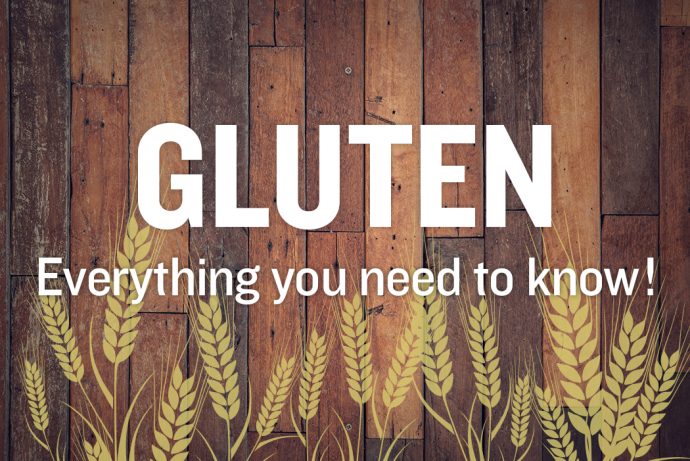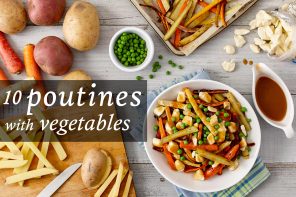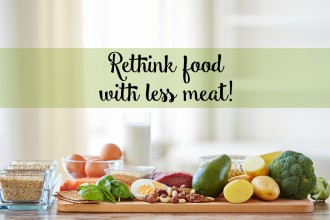Beer, ketchup, chicken tenders and cake have one thing in common: they all contain gluten! But don’t panic if you’re on a gluten-free diet. With a little research, you’ll find gluten-free equivalents for many products. The only downside? Some gluten-free products like bread don’t taste as good as their gluten counterparts.
Even though in the last few years the words “gluten-free” have become part of our daily life, people still have questions. What is gluten, anyway? What food is it found in? Should I be decreasing my gluten consumption or even exclude it from my regular diet? How do you cook without gluten?
So today we’re exploring the theme of gluten to get to the bottom of the most common questions on the subject.
What is gluten and where is it hiding?
What is gluten? |
|
|---|---|
|
Composition : Mainly protein component composed of prolamines and glutelins
|
|
 |
Role : To add texture to baked goods and trap carbon dioxide during baking to provide volume to the dough
|
 |
Intolerance : Gluten intolerance affects 1% of the population
|
 |
Food affected : Grains: rye, wheat, barley, oats (often contaminated), etc.
|
|
Unusual food
|
|
 |
Gluten-free : Food without gluten: rice, corn, tofu, legumes, potatoes, oilseeds (flax, sesame, etc.), nuts, etc.
|
Found in many grains, gluten is an excellent source of minerals, fibre and protein. It’s used mainly to give texture and volume to baked goods. As it’s often used as a thickening or binding agent for making products that would surprise you like chocolate, soya sauce and even salad dressings, you should be careful if you want to exclude it from your diet. For a complete list of food with and without gluten, consult this guide, “General authorized/unauthorized products for a gluten-free diet”.
Gluten-free

Gluten intolerance
Often confused with allergy or sensitivity to gluten, gluten intolerance or celiac disease is a hereditary illness that affects about 1% of the population and is triggered by consuming grains containing gluten. People afflicted by this illness have intestines that behave abnormally. The cells in their intestinal wall are spaced too far apart and allow gluten to pass through. This disease causes negative responses in the immune system. It deteriorates the small intestine which, in turn, reduces its ability to absorb calcium and proteins. For the moment, the only treatment is to follow a gluten-free diet.
So now you must be asking yourself what’s the difference between being allergic, sensitive or intolerant to gluten. Having a real gluten allergy is very rare and unlike being intolerant, it doesn’t weaken the small intestine. Instead, consuming gluten for someone who’s truly allergic causes respiratory or digestive problems like many other allergic reactions. There isn’t a test for people who are sensitive to gluten. It’s more of a self-diagnosis by those who are affected which is between 0.5% and 6% of the population according to studies.
Symptoms of gluten intolerance
According to Health Canada, possible symptoms of celiac disease include :
| Children |
Adults |
|
|---|---|---|
|
|
According to Health Canada, gluten intolerance can be diagnosed with blood tests, a biopsy of the intestinal tract or relief of symptoms following gluten withdrawal from the diet.
Cooking without gluten
Adapting recipes
Most recipes can be prepared with gluten-free ingredients. If a recipe calls for flour, you’ll be happy to learn that rice, corn, potato, amaranth, tapioca, millet and buckwheat flour are naturally gluten-free. However, sometimes during the manufacturing process, they can become contaminated, so you should look for the words “gluten-free”. And if you’re looking for gluten-free grains, you’ll enjoy corn, quinoa, buckwheat and rice.
Gluten-free flour doesn’t have the same properties as wheat flour. That’s why combining different kinds of flour to get a product that’s as gluten-free as possible is recommended. We’ve prepared a table that explains the benefits, inconveniences and combination possibilities of different kinds of gluten-free flour.
| Advantages | Disadvantages | Mix with | Often used to make | |||||
|---|---|---|---|---|---|---|---|---|
 Rice flour Rice flour |
Neutral taste (can be used in any recipe) | Crumbly texture if too much is used | Mix with buckwheat flour or cornstarch | Cakes, bread |
 Buckwheat flour Buckwheat flour |
Very versatile, rustic taste | Fairly dense | Mix with rice flour or cornstarch | Pastries |
 Chickpea flour Chickpea flour |
Slightly sweet | Doesn’t rise | Mix with rice flour, often used to prepare salty dishes | Pizza dough, pancakes, bread, cakes |
 Chestnut flour Chestnut flour |
Pleasant taste | Doesn’t rise well | Mix with rice flour or cornstarch | Cakes, cookies |
 Corn flour Corn flour |
Nice golden colour, more or less neutral taste (Can be used in any recipe) | High glycemic index | Mix with cornstarch | Pastries, cookies, cakes, pancakes, pie crusts, bread |
 Quinoa flour Quinoa flour |
Rich in amino acids and low glycemic index | Pronounced flavour | Mix with milder flour like rice flour | Muffins |
 Tapioca flour Tapioca flour |
Texture similar to starch | Mix with rice flour | Bread, cakes |
 Coco flour Coco flour |
Unique taste | Expensive | Mix with rice flour | Sauces, pastries, cakes |
For even more ideas on combining flour, recipes and different types of flour, consult this little directory of gluten-free flour.
Gluten-free menu ideas
To help you come up with recipes without gluten, we’ve concocted a little menu that’s completely gluten-free.
Breakfast/brunch

Broccoli and sun-dried tomatoes frittata
Supersweet Corn and Scrambled Eggs
Appetizers

Warm potato salad with grilled lettuce
Main dishes

Tomato and basil pizza on cauliflower crust
Roasted sesame salmon and pea coulis with garden herbs
Sides

Desserts

Snacks

To eat or not to eat gluten?
Effects of a gluten-free diet
Depending on each person’s predisposition, the effects of adopting a gluten-free diet vary. This means that for every person who’s intolerant, allergic, sensitive or who adopts a gluten-free by choice, the results won’t be the same. Therefore, for people who are intolerant, Health Canada specifies that this diet will lead to the restoration and return of a proper functioning intestine. For people who are allergic, it will help keep them away from respiratory, digestive or other problems due to allergic reaction, explains the president of l’AFDIAG, the association of gluten intolerance in France. Note that according to the Ordre professionnel des diététistes du Québec (OPDQ), people who want to adopt a gluten-free diet should do so under a physician’s supervision as it can come with certain risks. Consequently, for those who aren’t celiac or allergic, it’s suggested that they consume gluten because grains are an excellent source of minerals, fiber and protein.
So now that you know what gluten is and what you can replace it with in your recipes if you want to avoid it, we invite you to share your gluten-free recipes and tricks on how to find gluten-free food at the grocery store!








